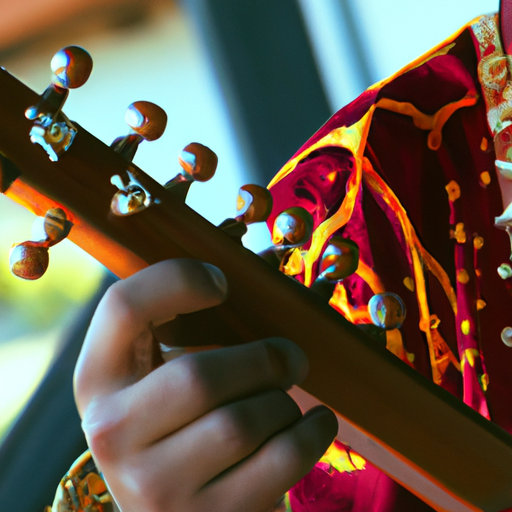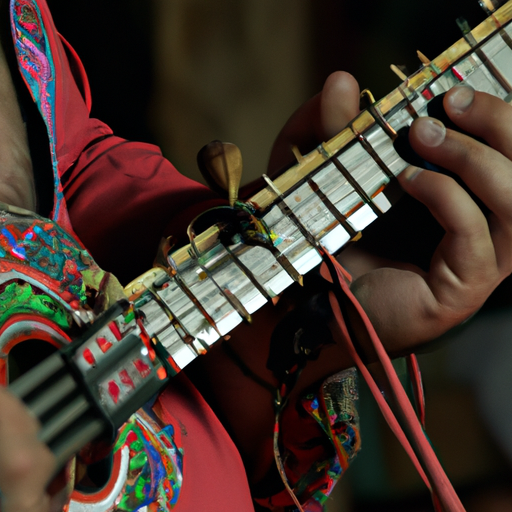Table of Contents
-
- Introduction
- The Preservation of Kashmiri Folk Music: Challenges and Opportunities
- The Impact of Kashmiri Folk Music on Modern Music: A Comparative Analysis
- The Lyrics of Kashmiri Folk Music: A Reflection of Culture and Traditions
- The Role of Instruments in Kashmiri Folk Music: An Overview
- Exploring the Origins of Kashmiri Folk Music: A Historical Perspective
- Q&A
- Conclusion
Introduction
Kashmiri folk music is a unique and beautiful form of music that has been passed down through generations. It is a harmonious journey through the traditions of the Kashmiri people, and also it is a reflection of their culture and history. The music features traditional instruments like the sarangi, sitar, and tabla, and also incorporates vocal harmonies. It offers a soothing and uplifting experience, allowing the expression of joy, sorrow, and also love. A beautiful and timeless art, has captivated people for centuries.
The Preservation of Kashmiri Folk Music: Challenges and Opportunities
It is an important part of the culture and heritage of the Kashmiri people. A unique form of music has passed down through generations and continues to be enjoy today. Unfortunately, the preservation of this music is facing many challenges. In this article, we will discuss the challenges and opportunities for preserving Kashmiri folk music.
It is the lack of resources
One of the biggest challenges to preserving Kashmiri folk is the lack of resources. Many of the traditional instruments used to play this music are becoming increasingly difficult to find. Additionally, there is a lack of funding for research and preservation efforts. Without adequate resources, it is difficult to ensure that this music is preserve for future generations.
Another challenge is the changing nature of the music itself. As the culture of Kashmiri people evolves, so does the music. This can make it difficult to preserve the traditional forms of the music. Additionally, the influence of other forms of music, such as Bollywood, can make it difficult to keep the traditional forms of Kashmiri folk music alive.
Use of Technology
Despite these challenges, there are also opportunities for preserving Kashmiri music. One of the most important is the use of technology. Technology enables the recording and preservation of traditional forms of music, making access and sharing easier. Furthermore, it facilitates the creation of new musical forms, allowing for evolution while maintaining the integrity of tradition.
Potential for Collaboration Between Different Groups
Finally, there is the potential for collaboration between different groups. By working together, different groups can share resources and knowledge to help preserve the music. This could include collaborations between musicians, researchers, and also other stakeholders.
In conclusion, the preservation of Kashmiri folk music is facing many challenges. However, there are also opportunities for preserving this important part of the culture and heritage of the Kashmiri people. By utilizing technology, collaborating with different groups, and also investing in resources, we can ensure that this music is preserved for future generations.
The Impact of Kashmiri Folk Music on Modern Music: A Comparative Analysis
It has had a profound impact on modern music. From the traditional instruments used to the unique melodies and rhythms, it has been a source of inspiration for many modern musicians. In this article, we will explore the influence of it on modern music and compare the two styles.
Traditional Instruments
It’s features traditional instruments like the sarangi, rubab, and also sitar, which artisans employ to craft distinctive melodies and rhythms setting it apart from other musical genres. These melodies frequently draw inspiration from traditional ragas, which serve as scales to evoke specific moods and emotions. The rhythms are often complex and intricate, making them difficult to replicate.
Modern music has been heavily influenced by Kashmiri folk music. Many modern musicians have adopted the use of traditional instruments, such as the sarangi, the rubab, and also the sitar. They have also incorporated the unique melodies and rhythms of it into their own compositions. This has resulted in a fusion of traditional and modern styles, creating a unique sound that is both familiar and new.
When comparing Kashmiri folk music to modern music, there are some distinct differences. Modern music frequently exhibits greater complexity and layering, as musicians employ multiple instruments and sounds to craft a more robust auditory experience. Furthermore, it frequently undergoes substantial production, utilizing technology to elevate the overall sound quality. In contrast, Kashmiri folk music is often simpler and more organic, relying on the traditional instruments and melodies to create a unique sound.
Overall
Overall, Kashmiri folk music has had a significant impact on modern music. From the traditional instruments used to the unique melodies and rhythms, Kashmiri folk music has been a source of inspiration for many modern musicians. By combining traditional and modern styles, musicians have been able to create a unique sound that is both familiar and new.
The Lyrics of Kashmiri Folk Music: A Reflection of Culture and Traditions

It is a reflection of the culture and traditions of the Kashmiri people. It is a unique form of music that has been passed down through generations and is still enjoyed today.
Kashmiri folk music frequently enlivens weddings and other special occasions. It also plays a significant role in celebrating festivals and other important events. Traditional dances often accompany the music, synchronizing with its rhythmic melodies.
It is a beautiful and unique form of music that reflects the culture and traditions of the Kashmiri people. It is a reminder of the rich history and culture of the region and is a source of pride for the people of Kashmir.
The Role of Instruments in Kashmiri Folk Music: An Overview
It is an integral part of the culture of the Kashmir Valley, located in the northernmost part of India. The unique blend of traditional and modern music in this composition stands out due to its utilization of a variety of instruments, which work together to produce a captivating and soothing sound.
To create a unique and captivating sound that soothes, musicians use these instruments. They employ them to craft a wide range of musical styles, including classical, folk, and also Sufi. Furthermore, these instruments are integral in shaping diverse musical forms such as ragas, thumris, and also ghazals.
In addition to the instruments, the vocalists also play an important role in Kashmiri folk music. The vocalists use their voices to create a unique sound that is both captivating and soothing. They use their voices to create a variety of different musical styles, such as classical, folk, and also Sufi.
Exploring the Origins of Kashmiri Folk Music: A Historical Perspective
Kashmiri folk music stands as a unique and vibrant form of music that generations have passed down. It reflects the culture and history of the Kashmiri people, bearing the imprints of the various influences that the region has embraced over the centuries. In this article, we will explore the origins of it and its evolution over time.
Ancient Vedic Period
It has its roots in the ancient Vedic period, when the region was part of the Hindu kingdom of Kashmir. During this period, Vedic chants and hymns heavily influenced the music, which people used in religious ceremonies and rituals. You can still hear this influence in the traditional folk songs of Kashmir today.
The arrival of Islam to the region in the 14th century brought with it a new set of musical influences. Persian and Arabic music started to blend with traditional folk songs, shaping the lyrics to mirror the Islamic faith. This influence continues to resonate in Kashmir’s traditional folk songs even today.
Mughal period
The Mughal period gave rise to a unique Kashmiri folk music style, heavily influenced by the court music of the Mughal Empire. This style featured intricate melodies and complex rhythms, often incorporating the tabla and sitar as accompaniments. The traditional folk songs of Kashmir still reflect this enduring influence. British soldiers brought with them a variety of musical instruments, and they used these instruments to create a unique blend of Indian and Western music. This influence is still audible in the traditional folk songs of Kashmir today.
It has evolved over the centuries, and continues to be an important part of the culture and history of the region. It is a reflection of the various influences that have come to the region over the centuries, and is a testament to the resilience and creativity of the Kashmiri people.
Q&A
1. What is the origin of Kashmiri folk music?
It has its roots in the ancient Vedic culture of India. The Kashmiri people believe in passing it down through generations, and it has been influenced by various other cultures, including Persian, Turkish, and Afghan.
2. What instruments are used in Kashmiri folk music?
It’s typically features a variety of instruments, such as the sarangi (a bowed string instrument), the sitar (a plucked string instrument), the tabla (a pair of hand drums), the harmonium (a keyboard instrument), and the dholak (a two-headed drum).
3. What are some of the most popular Kashmiri folk songs?
Some of the most popular Kashmiri folk songs include “Chaar Churiyan”, “Chunri”, “Dama Dam Mast Kalandar”, “Gul Gulshan”, “Kashmiri Kailash”, “Kashmiri Pahari”, “Kashmiri Sufiyana”, and “Rang Barse”.
4. What is the significance of Kashmiri folk music?
it is an important part of the culture and heritage of Kashmir. It is often used to express emotions, tell stories, and celebrate special occasions. It is also used to bring people together and create a sense of unity.
5. How can I learn more about Kashmiri folk music?
There are many resources available to learn more about that. You can find books, websites, and videos that provide information about the history, instruments, and songs of it. You can also attend concerts and festivals to experience the music firsthand.
Conclusion
Kashmiri folk music is a beautiful and harmonious journey through the traditions of the Kashmiri people. It is a unique and vibrant form of music that has been passed down through generations and continues to be enjoyed by people of all ages. The music is a reflection of the culture and history of the region, and its melodies and rhythms are a source of joy and inspiration for many. It is a timeless and captivating form of music that will continue to be enjoyed for generations to come.
More Blog: Best Travel Agency for Kashmir Tour



0 Comment